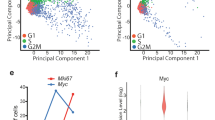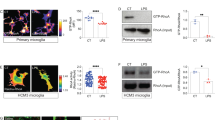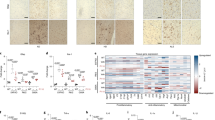Abstract
Excitotoxic brain lesions initially result in the primary destruction of brain parenchyma, after which microglial cells migrate towards the sites of injury. At these sites, the cells produce large quantities of oxygen radicals and cause secondary damage that accounts for most of the loss of brain function. Here we show that this microglial migration is strongly controlled in living brain tissue by expression of the integrin CD11a, regulated by the nuclear enzyme poly(ADP-ribose) polymerase-1 (PARP-1) through the formation of a nuclear PARP–NF-κB-protein complex. Downregulation of PARP or CD11a by transfection with antisense DNA abrogated microglial migration almost completely and prevented neurons from secondary damage.
This is a preview of subscription content, access via your institution
Access options
Subscribe to this journal
Receive 12 print issues and online access
$209.00 per year
only $17.42 per issue
Buy this article
- Purchase on Springer Link
- Instant access to full article PDF
Prices may be subject to local taxes which are calculated during checkout





Similar content being viewed by others
References
Mabuchi, T. et al. Contribution of microglia/macrophages to expansion of infarction and response of oligodendrocytes after focal cerebral ischemia in rats. Stroke 31, 1735–1743 (2000).
Stoll, G., Jander, S. & Schroeter, M. Inflammation and glial responses in ischemic brain lesions. Prog. Neurobiol. 56, 149–171 (1998).
Eliasson, M. J. et al. Poly(ADP-ribose) polymerase gene disruption renders mice resistant to cerebral ischemia. Nature Med. 3, 1089–1095 (1997).
Zhang, J., Dawson, V. L., Dawson, T. M. & Snyder, S. H. Nitric oxide activation of poly(ADP-ribose) synthetase in neurotoxicity. Science 263, 687–689 (1994).
Ha, H. C. & Snyder, S. H. Poly(ADP-ribose) polymerase-1 in the nervous system. Neurobiol. Dis. 7, 225–239 (2000).
Dantzer, F. et al. Involvement of poly(ADP-ribose) polymerase in base excision repair. Biochimie 81, 69–75 (1999).
Pieper, A. A. et al. Poly(ADP-ribosyl)ation basally activated by DNA strand breaks reflects glutamate-nitric oxide neurotransmission. Proc. Natl Acad. Sci. USA 97, 1845–1850 (2000).
Colton, C. A. & Gilbert, D. L. Microglia, an in vivo source of reactive oxygen species in the brain. Adv. Neurol. 59, 321–326 (1993).
Ullrich, O. et al. Turnover of oxidatively damaged proteins in BV-2 microglial cells is linked to their activation state by poly-ADP-ribose polymerase. FASEB J. 15, 1460–1462 (2001).
Hailer, N. P., Heppner, F. L., Hass, D. & Nitsch, R. Astrocytic factors deactivate antigen presenting cells that invade the central nervous system. Brain Pathol. 8, 459–474 (1998).
Hailer, N. P., Heppner, F. L., Haas, D. & Nitsch, R. Fluorescent dye pre-labelled microglial cells migrate into hippocampal slice cultures and ramify. Eur. J. Neurosci. 9, 863–866 (1997).
Heppner, F. L., Skutella, T., Hailer, N. P., Haas, D. & Nitsch, R. Activated microglial cells migrate towards site of excitotoxic neuronal injury inside organotypic hippocampal slice cultures. Eur. J. Neurosci. 10, 3284–3290 (1998).
Adamchik, Y., Frantseva, M. V., Weisspapir, M., Carlen, P. L. & Perez Velazquez, J. L. Methods to induce primary and secondary traumatic damage in organotypic hippocampal slice cultures. Brain Res. Protocols 5, 153–158 (2000).
Laake, J. H., Haug, F.-M., Wieloch, T. & Ottersen, O. P. A simple in vitro model of ischemia based on hippocampal slice cultures and propidium iodide fluorescence. Brain Res. Protocols 4, 173–184 (1999).
Roebuck, K. A. & Finnegan, A. Regulation of intercellular adhesion molecule-1 (CD54) gene expression. J. Leukoc. Biol. 66, 876–888 (1999).
Oliver, F. J. et al. Resistance to endotoxic shock as a consequence of defective NF-κB activation in poly(ADP-ribose) polymerase-1 deficient mice. EMBO J. 18, 4446–4454 (1999).
Hassa, P. & Hottiger, M. O. A role of poly(ADP-ribose) polymerase in NF-κB transcriptional activation. Biol. Chem. 380, 953–959 (1999).
Pierce, J. W. et al. Novel inhibitors of cytokine-induced I-κB phosphorylation and endothelial cell adhesion molecule expression show anti-inflammatory effects in vivo. J. Biol. Chem. 272, 21096–21103 (1997).
D'Amours, D., Desnoyers, S., D'Silva, I. & Poirier, G. Poly(ADP-ribosyl)ation reactions in the regulation of nuclear functions. Biochem. J. 342, 249–268 (1999).
Gabriel, C., Justicia, C., Camins, A. & Planas, A. M. Activation of nuclear factor-κB in the rat brain after transient focal ischemia. Brain Res. Mol. Brain. Res. 65, 61–69 (1999).
Heyen, J. R., Ye, S., Finck, B. N. & Johnson, R. W. Interleukin (IL)-10 inhibits IL-6 production in microglia by preventing activation of NF-κB. Brain. Res. Mol. Brain Res. 77, 138–147 (2000).
Kameoka, M. et al. Evidence for regulation of NF-κB by poly(ADP-ribose) polymerase. Biochem. J. 346, 641–649 (2000).
Boulikas, T. Poly(ADP-ribosyl)ation, DNA strand breaks, chromatin and cancer. Toxicol. Lett. 67, 129–150 (1993).
Bielinska, A., Kukowska-Latallo, J. F., Johnson, J., Tomalia, D. A. & Baker, J. R. Regulation of in vitro gene expression using antisense oligonucleotides or antisense expression plasmids transfected using starburst PAMAM dendrimers. Nucleic Acid Res. 24, 2176–2182 (1996).
Bielinska, A. U., Kukowska-Latallo, J. F. & Baker, J. R. The interaction of plasmid DNA with polyamidoamine dendrimers: mechanism of complex formation and analysis of alterations induced in nuclease sensitivity and transcriptional activity of the complexed DNA. Biochim. Biophys. Acta 1353, 180–90 (1997).
Banati, R. B. & Graeber, M. B. Surveillance, intervention and cytotoxicity: is there a protective role of microglia? Dev. Neurosci. 16, 114–127 (1994).
Lehrmann, E. et al. Microglia and macrophages are major sources of locally produced transforming growth factor-β1 after transient middle cerebral artery occlusion in rats. Glia 24, 437–448 (1998).
Schlapbach, R. et al. TGF-β induces the expression of the FLICE-inhibitory protein and inhibits Fas-mediated apoptosis of microglia. Eur. J. Immunol. 30, 3680–3688 (2000).
Flanders, K. C., Ren, R. F. & Lippa, C. F. Transforming growth factor-betas in neurodegenerative disease. Prog. Neurobiol. 54, 71–85 (1998).
Krupitza, G. & Cerutti, P. ADP-ribosylation of ADPR-transferase and topoisomerase I in intact mouse epidermal cells JB6. Biochemistry 28, 2034–2040 (1989).
Krupitza, G. & Cerutti, P. Poly(ADP-ribosylation) of histones in intact human keratinocytes. Biochemistry 28, 4054–4060 (1989).
Ohashi, Y., Itaya, A., Tanaka, Y., Yoshihara, K., Kamiya, T. & Matsukage, A. Poly(ADP-ribosyl)ation of DNA polymerase β in vitro. Biochem. Biophys. Res. Commun. 140, 666–673 (1986).
Tsai, Y. J., Aoki, T., Maruta, H. et al. Mouse mammary tumor virus gene expression is suppressed by oligomeric ellagitannins, novel inhibitors of poly(ADP-ribose) glycohydrolase. J. Biol. Chem. 267, 14436–14442 (1992).
Wesierska-Gadek, J., Bugajska-Schretter, A. & Cerni, C. ADP-ribosylation of p53 tumor suppressor protein: mutant but not wild-type p53 is modified. J. Cell. Biochem. 62, 90–101 (1996).
Lautier, D., Lagueux, J., Thibodeau, J., Menard, L. & Poirier, G. G. Molecular and biochemical features of poly(ADP-ribose) metabolism. Mol. Cell. Biochem. 122, 171–193 (1993).
Perrella et al. High mobility group-I(Y) protein facilitates nuclear factor-κB binding and transactivation of the inducible nitric oxide synthetase promoter/enhancer. J. Biol. Chem. 274, 9045–9052 (1999).
Gahmberg, C. G., Valmu, L., Fagerholm, S. et al. Leukocyte integrins and inflammation. Cell. Mol. Life Sci. 54, 549–555 (1998).
Kim, J. S., Chopp, M., Chen, H., Levine, S. R., Carey, J. L. & Welch, K. M. Adhesive glykoproteins CD11a and CD18 are upregulated in the leukocytes from patients with ischemic stroke and transient ischemic attacks. J. Neurol. Sci. 128, 45–50 (1995).
Ullrich, O. et al. Poly-ADP-ribose-polymerase activates nuclear proteasome to degrade oxidatively damaged histones. Proc. Natl Acad. Sci. USA 96, 6223–6228 (1999).
Nagayama, T. et al. Activation of poly(ADP-ribose) polymerase in the rat hippocampus may contribute to cellular recovery following sublethal transient global ischemia. J. Neurochem. 74, 1636–1645 (2000).
Szabo, C. et al. Inhibition of poly(ADP-ribose) synthetase attenuates neutrophil recruitment and exerts antiinflammatory effects. J. Exp. Med. 186, 1041–1049 (1997).
Pieper, A. A. et al. Myocardial postischemic injury is reduced by polyADPribose polymerase-1 gene disruption. Mol. Med. 6, 271–282 (2000).
Zingarelli, B., Cuzzocrea, S., Zsengeller, Z., Salzman, A. L. & Szabo, C. Protection against myocardial ischemia and reperfusion injury by 3-aminobenzamide, an inhibitor of poly(ADP-ribose)synthetase. Cardiovasc. Res. 36, 205–215 (1997).
Giulian, D. & Baker, T. J. Characterization of ameboid microglia isolated from developing mammalian brain. J. Neurosci. 6, 2163–2178 (1986).
Emig, S., Schmalz, D., Shakibaei, M. & Buchner, K. The nuclear pore complex protein p62 is one of several sialic acid-containing proteins of the nuclear envelope. J. Biol. Chem. 270, 13787–13793 (1995).
Zwilling, S., Konig, H. & Wirth, T. High mobility group protein 2 functionally interacts with the POU domains of octamer transcription factors. EMBO J. 14, 1198–1208 (1995).
Sambrook, J., Fritsch, E. F. & Maniatis, T. Molecular Cloning 2nd edn (Cold Spring Harbor Laboratory, Cold Spring Harbor, New York, 1989).
Acknowledgements
This work was supported by a grant from the Deutsche Forschunsgemeinschaft to O.U. (UL177/2-1) and to R.N. (SFB507/C1). We thank T. Irico for careful secretary assistance.
Author information
Authors and Affiliations
Corresponding author
Rights and permissions
About this article
Cite this article
Ullrich, O., Diestel, A., Eyüpoglu, I. et al. Regulation of microglial expression of integrins by poly(ADP-ribose) polymerase-1. Nat Cell Biol 3, 1035–1042 (2001). https://doi.org/10.1038/ncb1201-1035
Received:
Revised:
Accepted:
Published:
Issue Date:
DOI: https://doi.org/10.1038/ncb1201-1035
This article is cited by
-
Identification of Poly(ADP-ribose) Polymerase 9 (PARP9) as a Potent Suppressor for Mycobacterium tuberculosis Infection
Phenomics (2023)
-
Poly (ADP-ribose) polymerase: An Overview of Mechanistic Approaches and Therapeutic Opportunities in the Management of Stroke
Neurochemical Research (2022)
-
PARP overactivation in neurological disorders
Molecular Biology Reports (2021)
-
Heat capacities and thermodynamic functions of d-ribose and d-mannose
Journal of Thermal Analysis and Calorimetry (2018)
-
MIF-CD74 signaling impedes microglial M1 polarization and facilitates brain tumorigenesis
Oncogene (2016)



